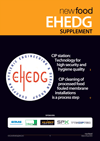Hygienic design of pumps: an EHEDG perspective
5 September 2012 | By Maxime Chevalier, EHEDG Member
Historically, maintaining the hygiene of a food process required a complete or partial disassembly and manual cleaning of every component (Cleaning out of Place: COP). The 1950’s saw the development of a method to clean the equipment without dismantling (Cleaning in Place: CIP) with the benefit of better repeatability, reduced…







